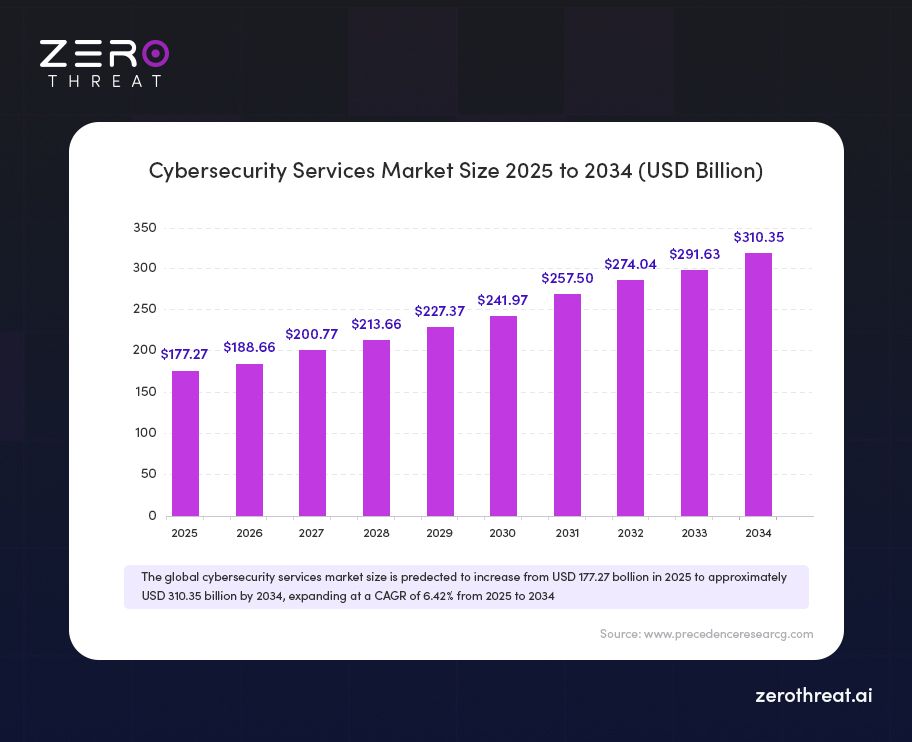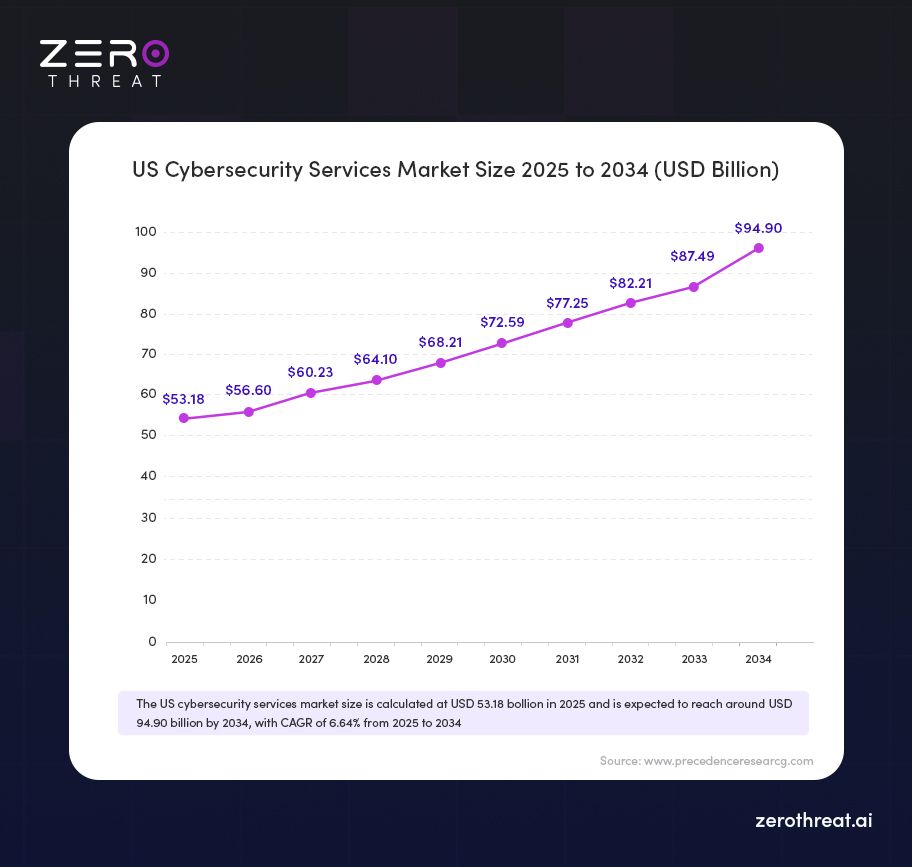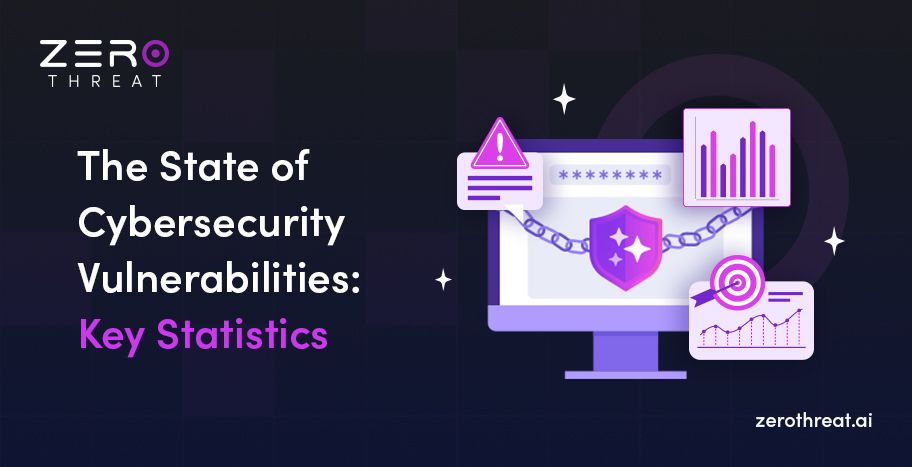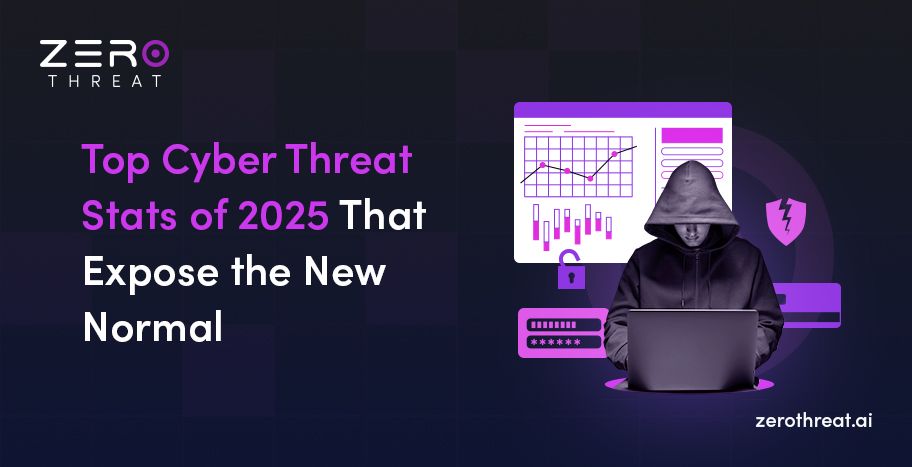All Blogs
Cybersecurity Statistics 2025: Unveiling Insights Behind the Numbers

Quick Summary: Curious to know what’s happening in the realm of cybersecurity in 2025? Keep reading for lots of cybersecurity statistics and facts that will provide deep insight into this field. Grab the information you need to make decisions or to understand more about the cybersecurity landscape.
According to recent cyber-attack statistics, 1,055 cyber incidents were reported in the previous year. Plus, 235 million were victims of those attacks. It shows the rising threats of cybercrimes. As more organizations adopt digitalization, this trend will continue upward.
CISOs and Security experts are also continuously working to overcome these challenges by leveraging advanced technologies. Moreover, with the constantly evolving cybersecurity landscape, they need more effective strategies to secure their digital landscapes.
Besides measures like continuous vulnerability assessment and strong security posture, they should also proactively identify gaps in their AppSec strategies. So, they must keep an eye on the latest cybersecurity trends and statistics to shape their strategies. Knowing the latest trends and statistics in cybersecurity in 2025 will help make informed decisions.
60% of Cyberattacks Take Place Due to Unpatched Vulnerabilities, Don’t Ignore It Hunt Them Now
Table of Contents
- Cybersecurity Quick Facts and Figures
- The Rising Size of the Cybersecurity Services Market
- A Glimpse of Trends and Stats in Cybersecurity
- Increasing Role of AI in Cyber Security for Defense and Attacks
- Cyber Security Statistics by Threat Vectors
- Understanding Statistics of Cyber Security by Technology
- To Wrap Up
Cybersecurity Quick Facts and Figures
Cybercrime is a growing concern for the world, and it’s going to be worse in the upcoming years with the advent of AI. The AI will enable attackers to launch more sophisticated attacks. To quote some data, the average cost of data breaches is consistently shooting up year on year, which currently stands at $4.90 million with a 10% increase, as per IBM’s DBIR.
With hackers attacking every 39 seconds on average, there is an urgent need to upgrade your defense mechanisms to mitigate security risks for web apps and other digital assets. Indeed, it’s high time you ramped up your security practices, as on average, 2200 cyberattacks occur in a day.
The latest cybersecurity statistics in 2025 indicate that Ransomware is the biggest security challenge for organizations around the world. There are more chilling ransomware statistics than any other security risk. In fact, 46% of organizations pay a ransom after a ransomware attack to get their data back.
Let’s check out some quick facts and figures related to cyber security data.
- The average cost of data breaches globally stands at 4.90 million.
- The average cost of a data breach in the U.S. is $9.44 million.
- The estimated cost of cyberattacks globally in 2025 is expected to reach $10.5 trillion.
- CISOs believe that human error is the biggest cyber vulnerability.
- A total number of 23,103 CVEs have been discovered in the first half of 2025.
- The United States faces the highest cost of a data breach.
- 35% of executives believe that reporting cyber risk management is essential for future growth.
- Only 14% of organizations are prepared to defend against a cyberattack.
- Shadow data is the major cause of data breaches, with 35% of cases.
- 66% of small businesses have had at least one cyberattack in the past few years.
- If the total cost of cybercrimes globally were worth a country, that would be the third largest by GDP after the USA and China.
Vulnerability Statistics and Facts
- According to a study, 84% of organizations have vulnerabilities categorized as high-risk.
- Half of potentially high-risk vulnerabilities can be removed as simply as updating software.
- Failing to apply a patch is the reason behind 60% of data breaches.
- Web applications usually have 4.6% of critical vulnerabilities.
- 70% of applications are likely to have a vulnerability after five years in production.
- On average, a security team spends 130 hours tracking and monitoring threats.
- Manual efforts take at least 20 minutes in the identification, prioritization, and remediation of a vulnerability.
- Log4Shell (CVE-2021-44228) is one of the biggest security challenges ever that still persists in a few systems.
The Rising Size of the Cybersecurity Services Market

As we look at the cybersecurity services market size, the data from research shows an upward trajectory from 2025 to 2034. The market size is expected to touch the USD 177.27 billion mark by the end of this year, and it stood at USD 166.58 billion.
Key takeaways from the cybersecurity services market research:
- The market size projections for cybersecurity services show that it will be USD 310.35 billion by 2034.
- The market will grow at a Compound Annual Growth Rate (CAGR) of 6.42% from 2025 to 2034.
- In 2024, North America dominated with the largest market share at 40% in the global market.
- The US cybersecurity market size will grow at a CAGR of 6.62% from 2025 – 2034, as shown in the image below.

- During the forecast period (2025-2034), cybersecurity market growth in the Asia Pacific will be the fastest.
- The managed services sector is projected to grow with the highest CAGR.
- In the upcoming years, the healthcare sector is expected to experience the fastest CAGR.
A Glimpse of Trends and Stats in Cybersecurity by Industry
As threat vectors become more intricate with sophisticated attack tactics, organizations need innovative methods to fortify their defenses. Almost every organization is susceptible to cyberattacks today, irrespective of the industry, due to increasing dependence on digital technologies and the internet. Attackers target organizations by exploiting vulnerabilities, implanting malware, or through social engineering tactics. Let’s check out cybersecurity stats for different industries.
Healthcare Industry
When it comes to cyber attack statistics, the healthcare industry is among the most vulnerable sectors to cyberattacks. There is a wide range of attacks that healthcare organizations have faced in the past few years. The attack methods have also increased with the use of more sophisticated technologies like IOMT (Internet of Medical Things). The following are a few cyber security stats for healthcare.
- In 2025, the average cost of data breaches in healthcare is expected to exceed USD 10 million.
- Yale New Health Haven System faced the biggest healthcare data breach in the US in 2025, exposing 5.5 million users’ data.
- 51 minutes is the MTTR (Mean Time to Recovery) for healthcare organizations.
- Almost every healthcare website faced a bot attack in the previous year.
- Human elements were the main reason for 68% of breaches.
- Hacking and IT incidents are the major reasons behind data breaches in healthcare.
- The healthcare industry continues to have the highest average cost of data breaches in the USA.
- Networks/servers were the most common place where breached data was stored.
- Malware-related breaches affected 14 million patients in the USA in the previous year.
- There were 707 ransomware attacks that were a major reason for healthcare.
- The U.S. Department of Health and Human Services’ (HHS) Office for Civil Rights (OCR) has reported an alarming 264% rise in healthcare ransomware attacks over the last five years.
Financial Industry
The financial industry is the most attacked industry after manufacturing. As firms in this sector handle a large volume of sensitive data, cybercriminals often target them. In this sector, banks are more exposed. An attack on this industry is dangerous for the financial stability of a country. Let’s see some cyber security stats in this industry.
- The cost of a data breach in the financial sector stands at 5.9 million on average.
- The financial sector ranks second in terms of the cost of data breaches.
- System intrusion has become a major threat vector in the finance and insurance sector.
- Social engineering is used in 78% of data breaches.
- In 95% of cases, the actual motive behind cyberattacks is financial.
Manufacturing Industry
There is an increase in error-related breaches in the manufacturing industry. It sits at the top of the list of most attacked industries worldwide, as per Statista. Almost a quarter of cyberattacks (25.7%) hit the manufacturing industry. Let's see more stats below.
- Social engineering, system intrusion, and miscellaneous errors account for 83% of data breaches.
- The use of stolen credentials is a reason for hacking in 25% of data breaches in the manufacturing industry.
- Currently, the manufacturing industry faces the most frequent cyberattacks at 23% of all security incursions globally.
- 50% of operational technology and industrial organizations don’t have sufficient cybersecurity expertise.
Eliminate Hidden Security Risks and Avoid Costly Data Breaches Let’s Do It
Educational Industry
The online educational services industry has revolutionized the way people learn, study, and read books. However, it’s not free from the menace of cybersecurity. It has been one of the key targets of hackers. The MOVEit data breach has been a significant incident in this industry. Let’s see some cyber security statistics about this industry.
- Backdoor was the primary type of action of malware for the educational industry in 57% of cases.
- Exploitation of vulnerabilities has been a major reason for hacking in this industry at 56%.
- According to Verizon’s DBIR 2025, the educational industry is one of the most affected industries that experienced 1075 security incidents.
- As per Intel’s report, there has been at least one successful cyberattack on educational establishments.
Retail Industry
The retail industry is among those that benefited from digital technology the most. However, the tech revolution also made it susceptible to cyberattacks. There is a wide range of cyber threats to the retail industry, such as stealing credit card information, POS attacks, data breaches, and more. The following are some cybersecurity stats for this industry.
- 24% of cyberattacks are faced by the retail industry.
- As per Statista, the retail and wholesale industry stands in the fifth position among the most targeted sectors for cyberattacks.
- The retail industry holds a share of 10.7% of the total number of cyberattacks.
- 78% of consumers are concerned about their data privacy.
Increasing Role of AI in Cyber Security for Defense and Attacks
Today, AI is the cornerstone of modern tech innovations and solutions. The cybersecurity industry is no exception. With the increasing role of AI in both defense and attack aspects, there will be a new age of cybersecurity.
Key AI-Offensive Trends
- As per stats, AI-powered cyber attacks are expected to rise, and 93% of business leaders expect daily AI-based attacks in 2025.
- Cyberattacks expected to leverage AI include phishing 38%, ransomware 48%, and bot attacks 16%.
- In email phishing attacks, AI is now being used in 82% of incidents, skyrocketing the success rate to 60%.
- According to Reddit, the use of AI is shown in 82.6% of phishing emails.
- Deepfake-based fraud has increased over the years by 3000%.
AI-driven Defense in Cybersecurity
- As per stats, 76-89% of organizations have integrated AI into their cyber defense mechanisms.
- 70% of organizations believe that the incorporation of AI in defense significantly improves threat detection and response.
- AI-based security systems are capable of blocking about 95% of phishing attacks, reducing response time by 35-60%.
- AI is being used by 56-58% of SOCs, and 43% of organizations now use preemptive AI.
AI in Cybersecurity Market and Investment Landscape
- The AI in the cybersecurity market is expected to cross USD 38 billion by 2026.
- Organizations are now allocating 40% of their budgets to AI-based systems.
Cyber Security Statistics by Threat Vectors
Cyber threats are increasing in variety as the world becomes more connected through digital technologies. There are different techniques that cybercriminals use today, and the number of potential attack vectors is increasing. In fact, there are 298,000+ entries in the National Vulnerability Database.
Phishing Statistics
- According to a report, 55% of phishing websites steal sensitive data by impersonating targeted brand names.
- In 13% of cases, Google and Amazon websites are impersonated, making them the most impersonated brands.
- Conducting regular training can help reduce the rate of employees falling prey to phishing attacks, stated by 85% of US organizations.
- Microsoft is the most targeted brand for phishing attacks at 33%.
- Phishing is the starting point for 74% of account takeover attacks.
- According to FBI’s (IC3) data, business email compromises account for 25% (one-fourth) of financially motivated attacks.
Malware Statistics

- Email is the most common attack vector for delivering malware in 88% of cases.
- Around 1.2 billion potentially unwanted applications and malicious programs exist.
- AV-TEST registers more than 450,000 malware every day.
- There were 190,000 malware attacks per second in the previous year, as per AVG.
Ransomware Statistics
- In the previous year, ransomware was detected the most.
- On average, 59% of organizations globally were victims of ransomware activity in the first quarter of the previous year.
- Ransomware-as-a-Service (RaaS) kits have increased the frequency of attacks.
- As per Cybersecurity Ventures, Ransomware costs are expected to soar to approximately USD 265 billion annually by 2031.
Understanding Statistics of Cyber Security by Technology
Cloud Security
- Human factor remains the main security risk for cloud according to Statista.
- Lack of budget is the main reason for half of IT teams to maintain security in the cloud.
- 50% of organizations prioritize the prevention of cloud misconfigurations for security.
- BYOD (Bring Your Own Device) security policies are a priority for 5% of organizations.
- For 12% of organizations, cloud security training is a priority.
- In 82% of data breach instances, data was stored in the cloud.
IoT Security
- Digital trust is considered important for IoT solutions by only 30% of providers.
- Denial-of-Service (DoS) and buffer overflow are the two most common vulnerabilities in IoT devices.
- On average 54% of organizations face cyberattacks attempting to target IoT devices every week.
- Around 20% of organizations have already experienced at least one cyberattack on IoT devices in the past three years.
Artificial Intelligence
- AI is essential for cybersecurity believed by 69% of organizations.
- The market size of AI in cybersecurity is estimated to reach $102.78 billion by 2032.
- Hackers used AI to steal $150 million worth of different digital assets including Bitcoin and Ethereum.
Vulnerable Systems are Easy Targets for Attackers, Make Sure It's Not Yours Uncover Security Risks
To Wrap Up
Cybersecurity is not constant; it’s evolving with new kinds of threats and exposures. CISOs and security experts should also continuously update themselves on these evolving changes with stats and trends. Knowing them provides deep insight into the threat landscape to align their strategies accordingly.
Besides, the rising adoption of Artificial Intelligence marks a new era in cybersecurity, especially when it comes to identifying and addressing critical vulnerabilities. Keeping up with the emerging cybersecurity trends and stats along with the role of emerging technologies like AI will enable CISOs and security experts to tackle security challenges more effectively.
Apart from staying updated with the latest trends and stats, the vital role of the right AppSec solution cannot be underestimated. With modern and AI-powered AppSec platform – ZeroThreat – you can efficiently identify and address vulnerabilities to stay ahead of hackers and protect your applications.
When it comes to seeking the right combination of innovation and emerging tech, ZeroThreat stands out from the rest. It offers threat assessment, advanced automated scanning, and zero false positives that make AppSec convenient and result driven.
Frequently Asked Questions
Which one is the number one cyber threat today?
Ransomware, malware, and social engineering are the top security challenges today. However, there is a wide range of cyber threats that affect various digital assets. Vulnerabilities are among the top reasons for cyberattacks.
Which trends are among the top three in cybersecurity?
Is it important to know statistics for cybersecurity?
Explore ZeroThreat
Automate security testing, save time, and avoid the pitfalls of manual work with ZeroThreat.


